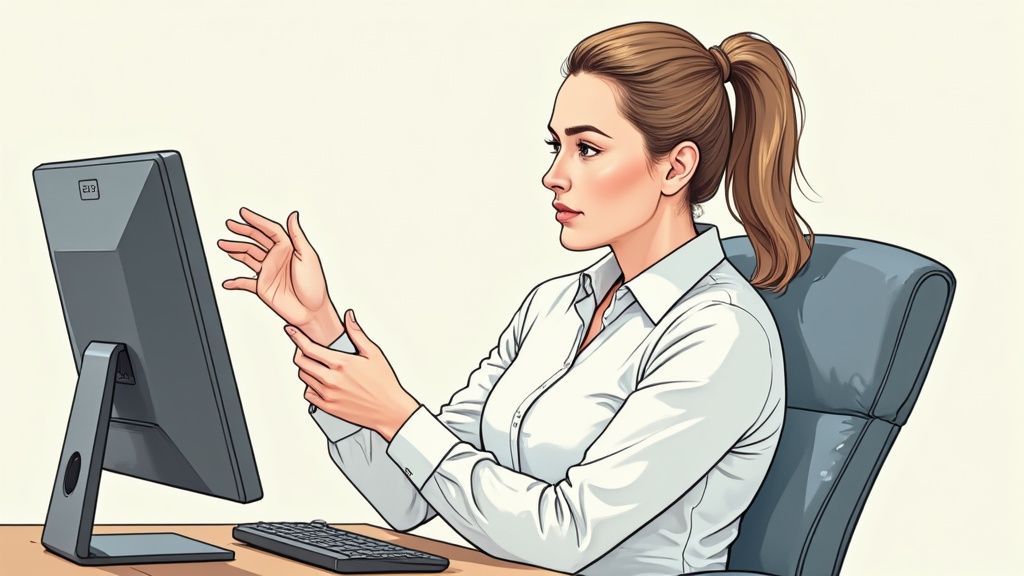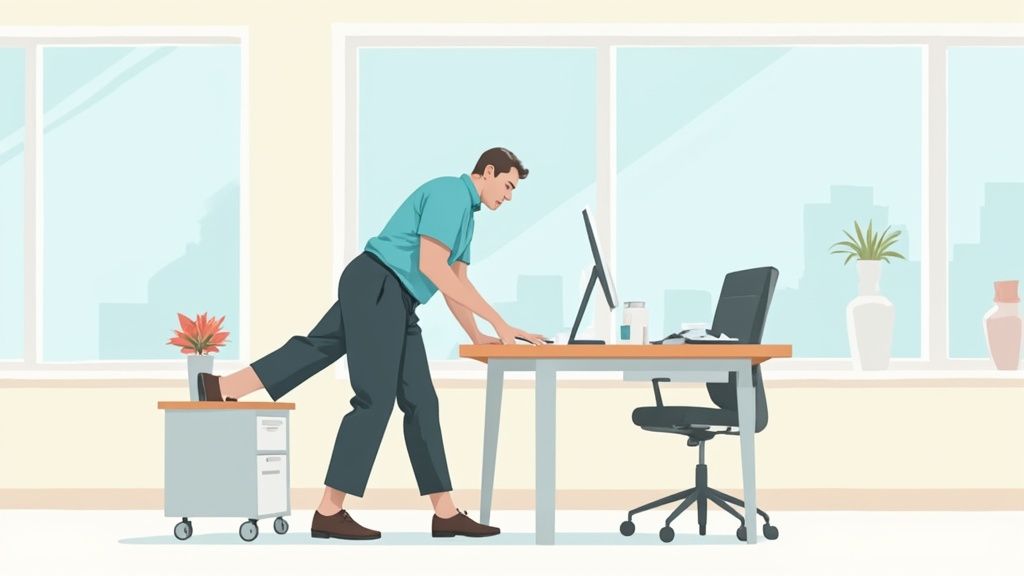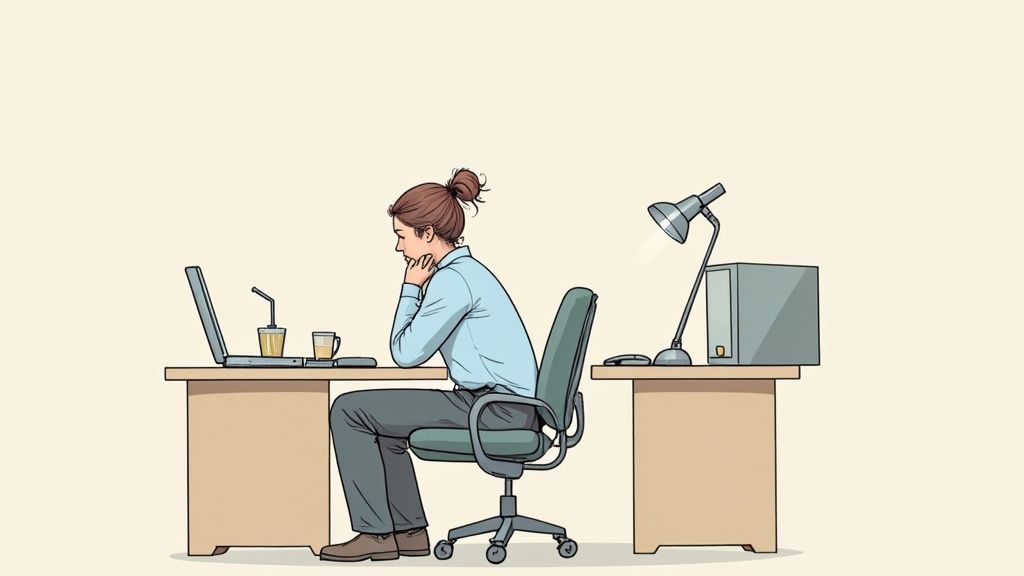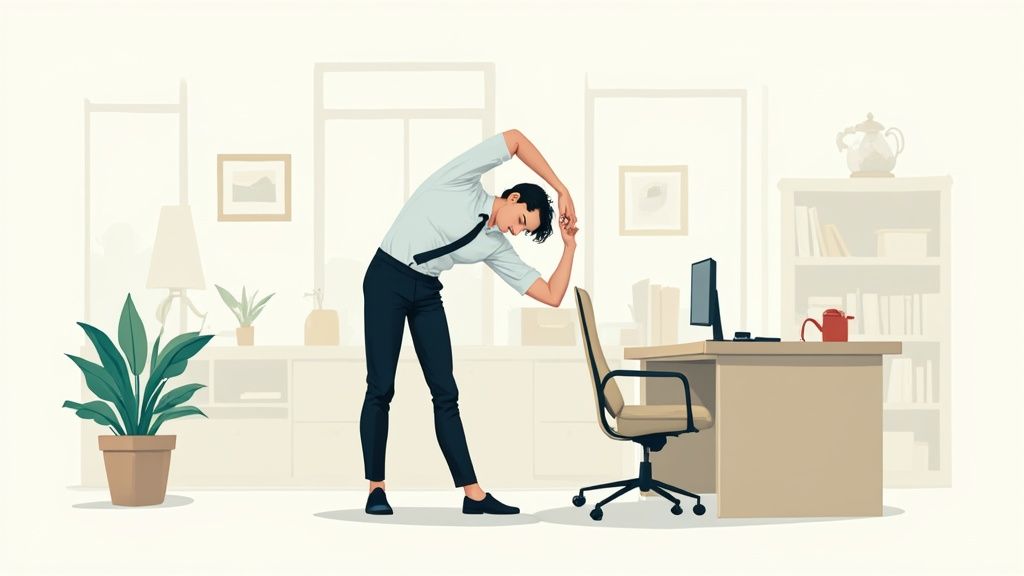10 Essential Desk Exercises at Work: Transform Your Office Health Without Leaving Your Chair
Understanding the Real Impact of Your Desk Job

Most office workers spend around 8 hours at their desk each day without realizing the serious effects on their health. Beyond just feeling stiff and sore, prolonged sitting can lead to lasting changes in your body. Understanding these impacts makes it clear why moving regularly during the workday is so essential.
The Hidden Consequences of Inactivity
Your metabolism slows significantly during long periods of sitting, similar to how a car idling for hours burns fuel inefficiently. When you remain sedentary, your body becomes less effective at processing fats and sugars, increasing risks for weight gain and type 2 diabetes. The problem gets worse when combined with desktop snacking, which many of us do mindlessly while working.
What's more concerning is the impact on heart health. Research shows that people who sit for over 10 hours daily face much higher risks of heart problems and cardiovascular-related death. This happens because sitting reduces blood flow throughout your body, forcing your heart to work harder. The good news? Taking just 30 minutes of movement breaks during your workday through simple stretches and exercises can help offset these risks.
Why Desk Exercises Matter
While regular exercise outside work hours helps, research suggests it's not enough on its own to counter a sedentary job. A major study of nearly 500,000 people found that desk workers had more health issues even when they exercised regularly after work. This shows why it's crucial to add movement throughout your workday - not to replace your normal workouts, but to break up long stretches of sitting.
Addressing Specific Problem Areas
Strategic desk exercises can help with common issues that develop from prolonged sitting:
Posture: Extended sitting often leads to slouching and poor posture. Simple exercises like shoulder blade squeezes and chin tucks can help maintain better alignment and reduce neck and back pain.
Circulation: Sitting restricts blood flow, especially to your legs, causing cramping and swelling. Basic movements like ankle rotations and calf raises get your blood moving again.
Stiffness: Hours of sitting tightens your hips and back. Regular torso twists and hip stretches help maintain flexibility and range of motion.
Small bursts of movement make a real difference over time. Set reminders to stand up every 30 minutes, take stretch breaks, or walk during lunch. While these changes may seem minor, they add up to significant benefits for your health and wellbeing when done consistently. The key is understanding how sitting affects your body and taking action through regular movement breaks.
Mastering Essential Desk Exercises That Actually Work

Long hours of sitting take a toll on our bodies, but there's a simple solution - desk exercises you can do right at work. These exercises are designed to be subtle yet effective, fitting seamlessly into your workday without drawing attention or disrupting your workflow.
Targeting Key Muscle Groups With Desk Exercises
When we sit for hours, certain muscle groups become particularly strained - especially the neck, back, shoulders, and legs. Simple movements like gentle neck rolls and shoulder blade squeezes can help counter the rounded posture that often develops from desk work. For instance, doing a few chin tucks throughout the day helps maintain proper neck alignment and reduces stiffness.
Blood flow also becomes restricted during prolonged sitting, particularly in the legs, which can lead to cramping and swelling. Basic movements like ankle rotations and calf raises get the blood moving again and help prevent these issues. The key is to move regularly, even if just for a minute or two at a time.
Incorporating Movement Into Your Workday
Here are some proven desk exercises you can start doing today:
Seated Leg Raises: Sit up straight with feet flat on floor. Extend one leg out in front, hold briefly, then lower. Switch legs. This works your core and leg muscles while improving circulation.
Desk Push-Ups: Place hands shoulder-width apart on desk edge, step back to create an incline, then lower chest toward desk and push back up. This modified push-up strengthens chest, shoulders and triceps.
Torso Twists: While seated upright, gently rotate your torso side to side. This simple movement helps maintain spine mobility and reduces back stiffness.
Shoulder Blade Squeezes: Sit tall and pull shoulder blades together for a few seconds before releasing. Repeat frequently to strengthen posture-supporting muscles.
Neck Rolls and Chin Tucks: Slowly roll neck in circles both directions, then draw chin back toward spine. These movements ease neck tension and promote good head position.
Try to do these exercises every 30 minutes throughout your day. Even short movement breaks make a difference in how you feel.
Enhancing Your Desk Exercises
Make these exercises even more effective with these strategies:
| Strategy | Benefit |
|---|---|
| Set Reminders | Helps you stay consistent with your movement breaks. |
| Walk During Breaks | Increases activity levels and improves circulation. |
| Use a Standing Desk | Reduces overall sitting time and promotes better posture. |
Building these simple habits can significantly improve how you feel at work. Remember that consistency matters more than intensity - even brief periods of movement add up over time. Tools like Moova can provide guided exercises and personalized plans to help you stay on track. In the next section, we'll explore how to create a movement routine that works with your schedule.
title: "Creating Your Personal Movement Strategy"
Creating Your Personal Movement Strategy

Now that we've covered key desk exercises for the workplace, let's focus on building a movement plan that works for you. This isn't about cramming intense workouts into your workday - it's about making small, consistent changes that help offset long periods of sitting. Since everyone's needs and schedules differ, personalizing your approach is key.
Assessing Your Current Work Habits
Start by looking at your daily work patterns. Count how many hours you typically sit each day. Notice if you already have movement habits like taking stairs or walking at lunch. This baseline helps set realistic goals that match your current routine. For instance, if you sit for eight hours straight now, start by aiming to stand for a total of one hour throughout your day.
Building a Realistic Movement Plan
The most effective approach is adding short movement breaks throughout your day. Rather than making drastic changes, start with brief exercises and gradually build up. Consider your schedule - if you have back-to-back meetings, quick 1-2 minute stretches between calls might work better than longer breaks.
Here's a simple weekly plan to get started:
- Monday: 3 sets of seated leg raises and torso twists, 10-minute walk during lunch.
- Tuesday: Desk push-ups and shoulder blade squeezes every hour, standing during phone calls.
- Wednesday: Repeat Monday's routine.
- Thursday: Neck rolls and chin tucks every 30 minutes, walk to talk to colleagues instead of emailing.
- Friday: Repeat Tuesday's routine.
Setting Reminders and Building Accountability
The hardest part is often remembering to take movement breaks. Set phone or computer alerts to prompt you to move. Keep them simple like "Time to move!" or specific like "Do 3 sets of leg raises." Find a coworker to be your "movement buddy" for stretches and walks. Apps like Moova can help by providing guided exercises and tracking your progress.
Integrating Movement With Other Wellness Practices
Movement works best when combined with other healthy habits. Keep water at your desk to stay hydrated. Choose nutritious snacks like fruits and vegetables over sugary options. Take time for stress-relieving activities like deep breathing or brief meditation. This well-rounded approach supports both physical and mental health, helping you feel more focused and productive at work.
Transforming Your Workspace for Maximum Movement

While having a solid movement plan is essential, your workspace setup plays an equally important role. Instead of just focusing on desk exercises, consider how your entire environment can naturally encourage more movement throughout your day. The good news is that you don't need expensive equipment - small, thoughtful changes can make a big difference.
Rethinking Your Office Setup for Desk Exercises at Work
Simple adjustments to your desk, chair, and equipment placement can significantly impact how much you move. For example, raising your monitor to eye level not only improves posture but also engages your core muscles as you sit up straight. This minor change can help reduce back pain and make you more comfortable throughout the day.
Your chair choice matters too. Many office chairs now support active sitting, which keeps your core and back muscles engaged. If getting a new chair isn't possible right now, try using a stability ball for part of your day - it's an affordable way to work on your balance and core strength while you work.
Consider the layout of your workspace. Are items like your printer, phone, or files within easy reach? Try placing them just far enough away that you need to stand up to get them. These small distance changes add up to more natural movement breaks in your day.
Creating a Movement-Friendly Environment
Look beyond your immediate desk area to find more opportunities for movement. Taking the stairs instead of the elevator is a classic example that really works - even just a few flights daily can boost your activity level significantly.
Start with easy changes that fit naturally into your routine. Place a footrest under your desk to keep your ankles moving, or keep your water bottle at a distance so you have to get up for refills. The key is finding ways to make movement feel like a natural part of your workspace rather than forced exercise.
Real-World Workspace Transformations
Many professionals have found creative ways to add more movement to their workday. One office added a shared treadmill desk that staff could use while working on laptops. This not only helped individuals stay active but created a positive ripple effect as more colleagues got inspired to move more. Another worker enhanced their standing desk setup with a balance board, making an ordinary workstation into an engaging space for core work and better focus.
By making these kinds of thoughtful changes to your workspace, movement becomes woven into the fabric of your workday rather than something you have to remember to do. This approach helps break free from constant sitting without requiring major lifestyle changes. It's about working with your environment to support better movement habits naturally.
Building Lasting Movement Habits That Stick
Creating a more active workspace and adding regular movement into your workday is an excellent first step. However, the real challenge lies in making these changes permanent parts of your daily routine. Rather than relying on willpower alone, success comes from having a solid strategy to build sustainable habits.
Setting SMART Movement Goals
The key to making desk exercises a consistent part of your workday is setting specific, measurable, achievable, relevant, and time-bound (SMART) goals. Instead of a vague goal like "move more at work," define exactly what actions you'll take. For instance: "I will do three sets of seated leg raises and two sets of torso twists every weekday during my lunch break for the next month." This gives you a clear target to work towards with measurable results.
Tracking Progress and Celebrating Wins
Keeping track of your movement habits helps maintain motivation over time. Use a simple notebook, spreadsheet, or an app like Moova to log your desk exercises. This makes it easy to see your progress and identify areas for improvement. Remember to celebrate small victories along the way - completing all your planned desk exercises for a week deserves recognition! These positive reinforcements help strengthen your commitment to staying active.
Overcoming Common Barriers to Desk Exercises at Work
Life often throws obstacles in our path - busy schedules, unexpected meetings, and fluctuating energy levels can all disrupt our exercise plans. The secret is preparing for these challenges in advance. For example, if you know you have back-to-back afternoon meetings, break up your movement into shorter sessions throughout the day. Finding an accountability partner at work can help you stay on track when motivation dips. Most importantly, be flexible - adjust your plan when needed rather than abandoning it completely.
Integrating Movement Into Your Work Culture
Making physical activity a team effort significantly boosts success rates. Try suggesting walking meetings, organizing group stretch breaks during the afternoon, or starting a friendly step-count challenge with colleagues. When movement becomes part of the workplace culture, it's easier to maintain these healthy habits. This shared commitment creates an energetic work environment where everyone benefits. You might even propose changes to the office layout, like adding a central water station or designated stretching area, to naturally encourage more movement throughout the day.
By combining personal commitment with workplace integration, you lay the foundation for lasting change. Focus on achievable goals, track your progress, prepare for challenges, and create a supportive environment. This practical approach helps counter the effects of sedentary work while building sustainable habits that improve your health and well-being.
Maximizing Impact: Combining Movement With Workplace Wellness
Adding desk exercises to your workday is a great start, but creating lasting positive change requires looking at workplace wellness as a whole. Just like a balanced meal needs multiple nutrients, optimal well-being at work comes from combining movement with other healthy practices. The most successful professionals understand this and take an integrated approach.
Fueling Your Movement: Nutrition and Desk Exercises at Work
Your body needs proper fuel to get the most out of desk exercises and recover effectively. Smart nutrition choices throughout the day make a big difference. For instance, starting your morning with protein and complex carbs gives you sustained energy for those movement breaks. Choosing whole foods like fruits, nuts, and vegetables over processed snacks helps maintain steady energy levels, especially during afternoon stretching sessions.
Managing Stress for Enhanced Wellness
High stress levels can get in the way of workplace wellness goals. When stress builds up, it becomes harder for your body to benefit from desk exercises and movement breaks. Taking a few minutes for deep breathing or quick meditation during breaks helps calm your mind and nervous system. As a result, you'll feel more energized and focused when doing desk exercises and tackling work tasks.
Optimizing Your Energy Levels for Peak Performance
To make the most of desk exercises, you need consistent energy throughout your workday. Getting quality sleep, drinking enough water, and taking regular breaks helps maintain your stamina. For example, a 10-minute walk at lunch not only provides movement but also refreshes your mind for the afternoon. Small habits like this compound to help you stay energized and productive.
Creating a Comprehensive Workplace Wellness Approach
The key is bringing together movement, nutrition, stress management and energy optimization in a way that works for you. When these elements work together, they amplify each other's benefits - like instruments in an orchestra creating harmony. This balanced approach supports both physical and mental wellbeing, leading to better focus, less stress, and a greater sense of vitality at work. Ready to create positive change in your workday? Moova provides personalized guidance to help you build movement into your routine and enhance your overall workplace wellness.







